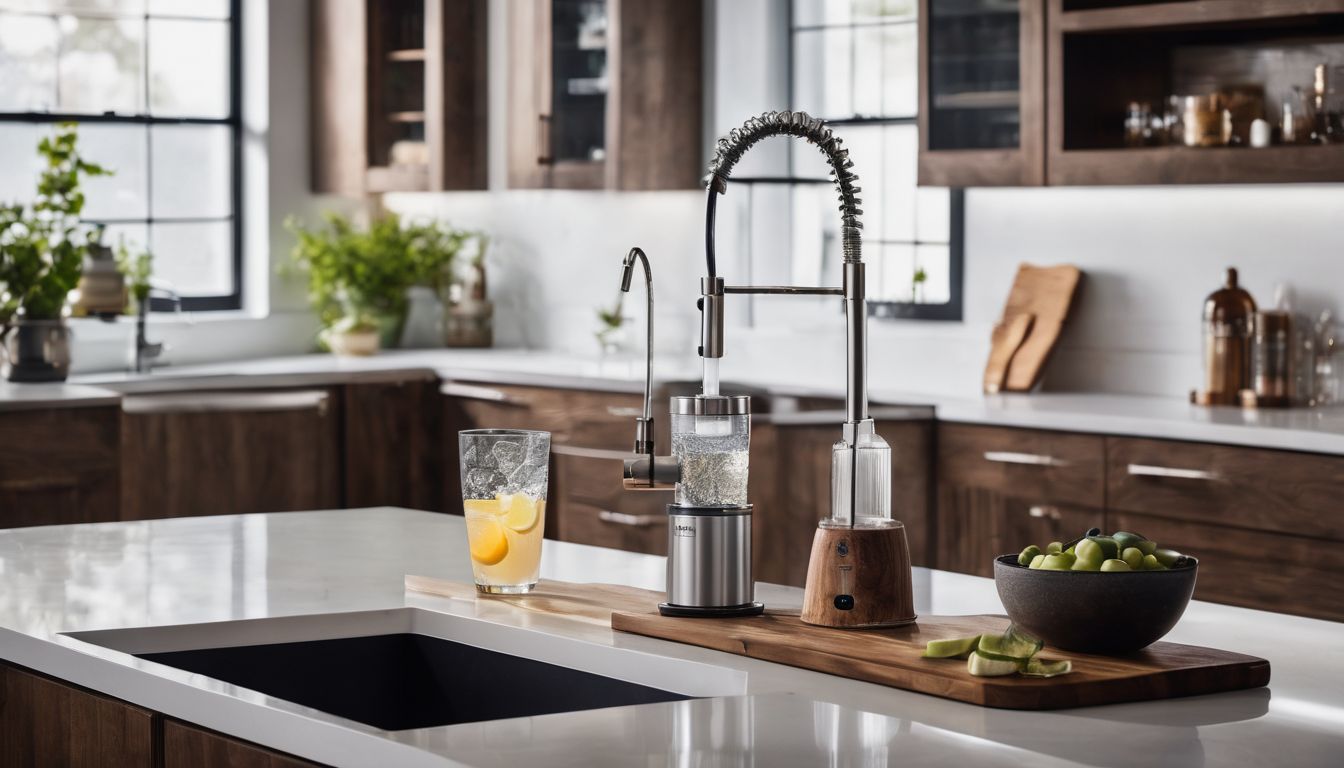 Drafty homes and high energy bills are common woes for many households. In the UK alone, inefficient energy use leads to over 20% of carbon emissions. This blog post will guide you through easy DIY projects that can boost your home’s energy efficiency and save money.
Drafty homes and high energy bills are common woes for many households. In the UK alone, inefficient energy use leads to over 20% of carbon emissions. This blog post will guide you through easy DIY projects that can boost your home’s energy efficiency and save money.
Dive in to discover how small changes make a big difference!
Key Takeaways
- Sealing and insulating your home can prevent heat loss, with simple tasks like using caulk around windows and doors or adding insulation to the attic making a big difference.
- Upgrading to energy – efficient appliances, such as refrigerators and washing machines, will reduce energy consumption while also saving money on utility bills in the long term.
- Installing smart technology, like programmable thermostats or solar panels, allows you to control energy usage more effectively, leading to increased savings and environmental benefits.
- Simple habits like washing clothes in cold water, air-drying laundry instead of using a tumble dryer, and monitoring charger use can contribute significantly towards reducing household energy waste.
- Regular maintenance of home systems including cleaning appliance coils and ductwork ensures they run efficiently; an annual professional inspection may detect issues that could be causing unnecessary energy use.
Understanding the Importance of Energy Efficiency
Understanding the importance of energy efficiency is crucial in reducing our impact on the environment and conserving natural resources. By reducing energy consumption, we can also save money and improve the overall comfort of our homes.
How energy waste impacts the environment
Energy waste takes a significant toll on our environment by increasing greenhouse gas emissions. As we burn more fossil fuels to produce electricity and heat for inefficient homes, carbon dioxide fills the atmosphere, contributing to climate change.
The excess energy use also leads to air and water pollution, harming wildlife and disrupting fragile ecosystems.
Vast amounts of water are required for cooling in power stations; misusing electricity means wasting this critical resource too. Moreover, energy waste puts a strain on limited natural resources as we struggle to keep up with high consumption rates.
By conserving energy through DIY home improvements, we help protect natural habitats and reduce harmful emissions that affect climate patterns globally.
The benefits of reducing energy consumption
Reducing energy consumption not only minimises environmental impact but also leads to significant cost savings over time. By implementing energy-efficient practices, homeowners can lower their utility bills and contribute to a greener planet.
Additionally, decreasing energy usage reduces the demand for fossil fuels, aiding in the preservation of natural resources and supporting sustainable living. Embracing DIY home energy efficiency improvements enables individuals to enjoy a more comfortable living environment while positively impacting the world around them.
Striving towards reducing energy consumption at home brings about tangible benefits such as lower electricity bills and a reduced carbon footprint. Making simple changes can lead to long-term positive effects on both personal finances and global sustainability efforts.
Simple DIY Projects for Energy Efficiency
Maintaining your furnace, insulating your water heater, and sealing ductwork are just a few simple DIY projects that can significantly improve the energy efficiency of your home. These small changes can make a big impact on reducing your energy consumption and lowering utility bills.
Tending to your furnace
Regular furnace maintenance is crucial for energy efficiency. Cleaning or replacing the filter every 1-3 months ensures optimal airflow and reduces energy consumption, making your home more eco-friendly.
Insulating ductwork prevents heat loss, improving the system’s overall performance. Schedule an annual professional inspection to detect and resolve any issues, keeping your furnace in peak condition.
By performing these simple tasks regularly, you can significantly reduce energy waste while also saving on utility bills. It’s an easy way to contribute to a more sustainable environment and make your home more energy-efficient without significant investment.
Insulating your water heater
After tending to your boiler, another effective way to increase energy efficiency in your home is by insulating your hot water cylinder. This simple DIY project can help reduce heat loss from the tank and pipes, leading to lower energy consumption and cost savings.
By adding an insulation jacket around your hot water cylinder and insulating hot water pipes, you can minimise standby heat losses and decrease the amount of time it takes for the water to reach a desirable temperature.
Additionally, this small investment can have a significant impact on reducing greenhouse gas emissions and promoting environmental sustainability.
Sealing ductwork
Sealing ductwork is a crucial step in improving home energy efficiency. Air leaks in the ducts can lead to wasted energy and higher utility bills. By sealing the gaps and joints, you can prevent heated or cooled air from escaping, ensuring that it reaches its intended destination within your home.
This straightforward DIY project not only reduces energy waste but also contributes to a more comfortable living environment while ultimately saving on energy costs.
Moreover, addressing ductwork issues helps maintain consistent temperatures throughout the house, minimising hot or cold spots, and prevents dust and allergens from being circulated through the HVAC system.
Testing windows and doors
Make sure windows and doors are properly sealed. Check for draughts using an incense stick, feeling for air movement around window frames and door edges. Look for daylight coming through gaps when the doors and windows are closed.
Inspect weather stripping for wear and tear, replacing if necessary. Utilise caulk or foam to seal any noticeable gaps or cracks around the frames.
When testing windows, ensure they open and close smoothly without resistance. Also, examine locks to guarantee they work effectively in securing the window shut.
Using ceiling fans
Ceiling fans are an energy-efficient way to cool your home. By circulating air, they help maintain a comfortable temperature without relying solely on air conditioning. This reduces the need for electricity and supports energy conservation efforts in your household.
Additionally, ceiling fans can be used year-round to improve air circulation and distribution of heated or cooled air, making them a versatile and cost-effective option for enhancing home energy performance.
When you use ceiling fans strategically, you can reduce your reliance on heating and cooling systems, leading to significant energy savings over time. Furthermore, integrating ceiling fans into your daily routine promotes eco-friendly living by minimising energy waste while maintaining comfort in your home.
Running appliances in the evening
Running appliances in the evening can help reduce stress on the energy grid during peak hours, contributing to overall energy efficiency. By running your dishwasher, washing machine, and dryer during off-peak times, you can lower your household’s electricity demand and contribute to a more sustainable energy consumption pattern.
This small change in routine can make a significant impact on reducing your carbon footprint and supporting environmental conservation efforts.
Now, let’s explore another simple but impactful DIY project for energy efficiency – Installing a clothesline.
Installing a clothesline
Installing a washing line in your garden is a simple and effective way to reduce energy consumption. By air-drying your laundry instead of using a tumble dryer, you can save on electricity and contribute to a greener environment.
It’s also an excellent way to enjoy the fresh outdoor scent on your clothing while reducing your carbon footprint.
Consider installing a retractable washing line that allows you to maximise space when it’s not in use, or opt for a traditional fixed-line setup for added convenience. Either way, embracing this eco-friendly alternative can lead to significant energy savings and help create an environmentally sustainable home.
Cleaning large appliances
Maintaining energy-efficient large appliances is crucial for reducing energy consumption. Regular cleaning of the coils and filters of refrigerators, freezers, and air conditioning units helps them run efficiently.
Vacuuming the refrigerator’s coils can save up to 6% in electricity costs. Clearing lint from dryer vents improves its efficiency while reducing fire hazards. It’s essential to ensure that microwave and oven seals are clean and intact to prevent heat loss during cooking.
Using these simple maintenance tips enhances energy efficiency at home.
Automating energy usage
Automate your energy usage with smart home technology to optimise energy efficiency. Use programmable thermostats to manage heating and cooling, reducing waste and saving money. Smart plugs and power strips can be programmed to turn off electronics and appliances when not in use, preventing phantom power consumption.
Install motion sensors for lighting to ensure lights are only on when needed, cutting down on unnecessary electricity use. These simple automation solutions help increase energy efficiency without sacrificing comfort or convenience.
Consider these easy-to-use technologies as a way of optimising energy usage in your home while maintaining a comfortable living environment. Up next: “Fighting phantom power consumption”.
Fighting phantom power consumption
Transitioning from automating energy usage to fighting phantom power consumption, you can take simple actions like unplugging chargers and appliances when not in use. Even though devices are off, they continue to draw power and contribute to unnecessary energy waste.
Utilising power strips with individual switches for various electronics allows you to completely cut off their power supply. By doing so, you minimise phantom power consumption and make a substantial contribution towards conserving energy at home while decreasing your environmental impact.
Watching chargers
Watching chargers is an essential part of energy-saving at home. Unplugging chargers when not in use prevents phantom power consumption, reducing overall energy usage. Simply unplugging phone chargers, laptop chargers, and other electronic device chargers when they are not actively charging can make a significant impact on energy conservation at home.
Moreover, investing in smart power strips or surge protectors that cut off power to devices when they are fully charged can also help reduce unnecessary energy waste. Being mindful of charger usage may seem small, but it contributes to a greener and more efficient home environment.
Investing in an energy audit
Investing in an energy audit can pinpoint areas for improvement, making your home more efficient. An audit evaluates your energy usage and identifies where you’re losing energy, helping you prioritise upgrades.
This action aligns with supporting conservation and environmental sustainability.
By identifying inefficiencies, you’ll be equipped to implement cost-effective solutions that save both energy and money. Conducting an energy audit aligns with the DIY energy-saving tips and home weatherization, empowering environmentally conscious individuals to take tangible steps towards reducing their carbon footprint.
Other Home Projects for Energy Efficiency
Thinking of other ways to improve your home’s energy efficiency? Consider installing a programmable or smart thermostat, washing clothes in cold water, upgrading to energy-efficient windows, and converting to a heat pump water heater.
These additional projects can further reduce your energy consumption and save you money in the long run.
Installing a programmable or smart thermostat
A programmable or smart thermostat allows you to set specific temperatures for different times of the day, reducing energy waste. This upgrade can save money and reduce your carbon footprint by optimising heating and cooling cycles.
Smart thermostats can learn your habits and adjust automatically, while programmable ones let you pre-set temperatures based on when you’re home or away. By using these devices, you’ll maintain a comfortable environment while maximising energy efficiency at home.
Washing clothes in cold water
Washing clothes in cold water reduces energy usage and lowers utility costs. Cold-water washing also helps preserve the fabric and prevents shrinking, making clothes last longer. Additionally, it minimises carbon emissions by decreasing the energy required to heat the water.
For environmentally conscious individuals looking to reduce their home’s energy consumption, switching to cold-water laundry cycles is a simple yet impactful step towards sustainable living.
By using cold water for washing clothes, you can contribute to both environmental conservation and cost-saving efforts without compromising on cleanliness and fabric care.
Upgrading to energy-efficient windows
Consider upgrading to energy-efficient windows to improve your home’s energy performance. By investing in double or triple-pane windows with low-emissivity coatings, you can minimise heat loss during the colder months and keep your home cooler in the summer.
This upgrade not only helps reduce your energy bills but also contributes to a more comfortable indoor environment, all while supporting an eco-friendly lifestyle.
To further enhance your home’s energy efficiency, consider converting to a heat pump water heater for lower energy consumption and reduced carbon footprint.
Converting to a heat pump water heater
Upgrading to a heat pump water heater can significantly reduce energy consumption and lower utility costs. By harnessing renewable energy from the air, these systems are far more efficient than traditional electric water heaters.
They work by extracting heat from the ambient air and transferring it to the water in the tank, making them an environmentally friendly choice for homeowners seeking energy-efficient appliances.
By making this change, you can take another step towards improving your home’s energy performance while contributing to environmental conservation efforts. It’s a simple yet impactful DIY project that aligns with your commitment to reducing energy waste at home.
Advanced Energy-Saving Projects
Upgrade your home’s insulation and air sealing, install an electric air-source heat pump, convert to electricity from fossil fuels, invest in a smart thermostat, consider installing solar panels or updating older home appliances for maximum energy efficiency.
Upgrading insulation and air sealing
Improving insulation and sealing air leaks can significantly reduce energy waste and lower utility bills. Adding insulation in the attic, walls, and floors helps in maintaining a consistent indoor temperature, reducing the workload on heating and cooling systems.
Sealing air leaks around windows, doors, and ducts prevents heated or cooled air from escaping outside. It also stops unconditioned outdoor air from seeping into your home.
Insulation upgrades not only enhance comfort but also contribute to environmental conservation by lowering greenhouse gas emissions. By addressing these key areas, homeowners can create an energy-efficient living environment that supports sustainable living while saving money over time.
Installing an electric air-source heat pump
When considering advanced energy-saving projects, upgrading insulation and air sealing can significantly impact your home’s energy efficiency. Another effective step is installing an electric air-source heat pump.
This eco-friendly system harnesses thermal energy from the air and uses it to efficiently heat and cool your home, reducing reliance on traditional heating methods. By making this upgrade, you’ll not only decrease your carbon footprint but also enjoy long-term cost savings on your energy bills while contributing to a greener environment.
Converting to electricity from fossil fuels
Switching from fossil fuels to electricity is a significant move towards reducing carbon emissions and protecting the environment. By transitioning to electric appliances, vehicles, and heating systems, you can contribute to lowering greenhouse gas emissions linked with burning coal, oil, and natural gas.
Replacing traditional fuel-based equipment with electric alternatives like heat pumps and water heaters reduces your home’s carbon footprint while simultaneously enhancing energy efficiency.
Converting to electricity from fossil fuels not only benefits the environment but also contributes to creating a more sustainable and eco-friendly living space for future generations.
Upgrading to a smart thermostat
Installing a smart thermostat is an effective way to optimise home energy usage. By automatically adjusting temperature settings based on your schedule and habits, you can significantly reduce heating and cooling waste.
This upgrade complements your efforts in achieving energy efficiency, allowing for greater control over energy consumption while contributing to environmental preservation.
Integrating a smart thermostat aligns with green living ideals, offering practical solutions for reducing overall energy use within the home.
Installing solar panels
Solar panels are an effective way to harness the sun’s energy and reduce reliance on non-renewable resources. Solar panels can be installed on rooftops or in open spaces, converting sunlight into electricity without producing any harmful emissions.
By investing in solar panels, homeowners can significantly decrease their carbon footprint while saving money on energy bills over time.
With advancements in technology, installing solar panels has become more affordable and accessible than ever before. Homeowners can take advantage of government incentives and rebates, making it a smart investment for both the environment and long-term financial savings.
Updating older home appliances
Transitioning from installing solar panels to updating older home appliances, consider replacing outdated appliances with energy-efficient models. Upgrading to modern appliances reduces energy consumption and lowers utility bills.
Newer models equipped with advanced technology are designed for optimal energy efficiency, contributing towards a greener environment while enhancing the performance of your household.
Replacing old home appliances can significantly reduce environmental impact by promoting eco-friendly practices in daily living. From refrigerators to washing machines, choosing efficient options ensures greater conservation and sustainability within your home.
Tips for Maximising Energy Savings
Consistently maintaining and monitoring energy usage is crucial for maximising energy savings. Taking advantage of tax credits and rebates, considering green-certification for your home, exploring no-upfront-cost options, and staying informed on energy-efficient home improvements are also essential steps in achieving maximum energy efficiency.
Consistently maintaining and monitoring energy usage
Regularly maintaining and monitoring energy usage is crucial for maximising home energy efficiency. By keeping track of your energy consumption, you can identify areas where improvements can be made, leading to reduced waste and lower utility bills.
Maintaining appliances, checking for air leaks, and ensuring efficient operation of heating and cooling systems are all part of this ongoing effort.
Managing your home’s energy use ensures that you are taking proactive steps towards reducing your carbon footprint and contributing to environmental conservation efforts. Additionally, staying aware of your energy consumption allows you to spot any unusual changes or patterns that may indicate potential issues with equipment or insulation – enabling timely intervention before problems escalate.
Taking advantage of tax credits and rebates
Explore the array of available tax credits and rebates for home energy efficiency improvements. Consider options such as the Residential Renewable Energy Tax Credit, designed to offset costs associated with installing solar panels or other renewable energy systems.
Investigate local and federal rebate programmes that incentivise energy-efficient appliance purchases, insulation upgrades, or smart thermostat installations. By taking advantage of these financial incentives, you can not only reduce your environmental impact but also save money on your home’s energy expenses.
Maximising the benefits of tax credits and rebates requires thorough research into eligibility criteria and application processes. Ensure that you stay informed about evolving opportunities in this ever-changing landscape to make the most out of potential savings while enhancing your home’s energy efficiency further.
Considering green-certification for your home
To maximise your home’s energy efficiency, consider obtaining green certification. This involves meeting specific criteria for sustainable and environmentally friendly construction or renovation.
By making your home more energy-efficient, you can reduce your carbon footprint and contribute to a healthier planet. Green-certified homes typically have lower utility bills, better indoor air quality, and higher resale value.
Green certification ensures that your home meets high standards of sustainability and energy efficiency. Plus, it demonstrates your commitment to environmental conservation. Before undergoing this process, research the available certifications and assess which one aligns with your goals for an eco-friendly home.
Exploring no-upfront-cost options
To explore no-upfront-cost options for improving home energy efficiency, consider contacting your local energy company to enquire about available programmes. Investigate potential rebates and incentives for installing energy-efficient appliances, upgrading insulation, or implementing other green home improvements.
Explore community-sponsored initiatives that provide low-interest loans or grants for making energy-saving upgrades to your home.
Investigate government tax credits and financial assistance schemes available for environmentally friendly projects around the house. Additionally, research non-profit organisations that may offer resources and guidance on accessing affordable or free solutions for enhancing your home’s energy performance.
Staying informed on energy-efficient home improvements
When considering energy-efficient home improvements, staying informed is key. Keeping up with the latest technologies and best practices can help you make informed decisions about your home’s energy efficiency.
Reading reputable sources, attending workshops, and networking with other environmentally conscious individuals can provide valuable insights into new developments in energy-efficient home improvements.
By staying informed on energy-efficient home improvements, you can stay ahead of the curve and ensure that your home remains as efficient as possible. This proactive approach will not only benefit the environment but also contribute to long-term cost savings and a more sustainable lifestyle.
Conclusion
In conclusion, DIY home energy efficiency improvements offer practical ways to reduce energy consumption and lower environmental impact. Upgrading insulation, installing smart thermostats, or using ceiling fans are effective methods.
By staying informed on energy-efficient practices and taking advantage of tax credits, you can make a significant difference in conserving energy. Remember that even small changes add up to create a more sustainable living environment for all.
FAQs
1. What are DIY home energy efficiency improvements?
DIY home energy efficiency improvements are changes you can make to your house that reduce the amount of energy it uses, like adding insulation or using energy-efficient appliances.
2. Can I save money by making my home more energy efficient?
Yes, implementing energysaving home improvements such as water heater insulation and upgrading to energyefficient appliances can help lower your bills.
3. How do I start a DIY project for home energy conservation?
Begin with easy ways to save energy at home; seal drafts around doors and windows, switch to LED bulbs, and insulate your loft are good starting points for DIY energy conservation projects.
4. Are there simple upgrades that improve my home’s energy performance?
Absolutely! Installing some basic draught-proofing or fitting reflective panels behind radiators boosts the performance quickly without needing expert skills.
5. Does improving insulation really make a big difference in my home’s efficiency?
Definitely! Properly installed insulation keeps heat inside during winter and outside during summer, which is essential for an energetically efficient household.





